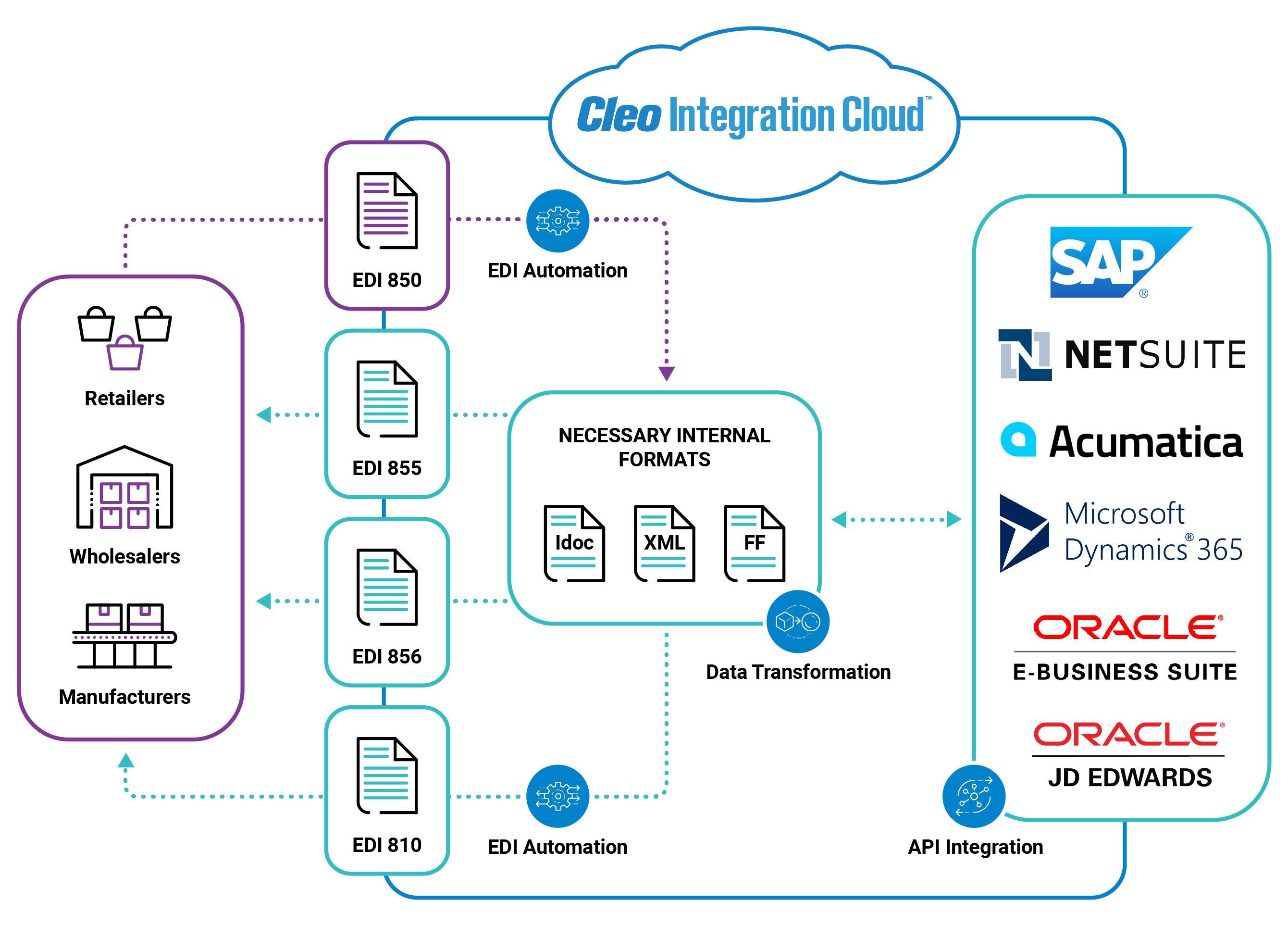What are the Primary Benefits to EDI Translation Software?

EDI remains the de-facto standard for B2B data exchanges, no matter the industry. Within today's ecosystem-driven business environment, companies need the ability to communicate quickly and efficiently with their trading partners, customers, suppliers, and vendors. But traditional EDI methods are no longer an ideal way to keep up with the pace of change.
Companies need EDI platforms that include translation that can accept and transform EDI (not to mention other formats, including XML and flat files) before moving that data to other systems and applications. A central integration platform provides that flexibility. In 2023, it's simply the cost of doing business, and maintaining those relationships is crucial to a thriving ecosystem.
What is an EDI Translator?
In the simplest form, an EDI translator is software that processes EDI data to and from a format that is compatible with specific software to regulated EDI formats that are known as EDI standards. An EDI translator allows companies to take one document that was customized in-house and convert it to an EDI standard to then send to another business who will convert the EDI standard into the format that is necessary for their enterprise.
How an EDI Translator Works
Imagine your company wants to check the status of an order with a supplier. Traditionally, this might involve:
- Determining Data: Determining what information is needed, like order number, customer ID, etc.
- Gathering Information: Gatherings that information from your various internal systems
- Structuring Data: Formatting the information in a way that your trading partner understands, potentially creating a document or email.
- Sending Request: Sending the request to your trading partner, typically via fax, email, or even a phone call
An EDI translator automates this entire process:
- Extracting/Converting Data: The translator retrieves the necessary data (order number, customer ID, etc.) from your internal systems, likely from a database or existing document
- Generating a Message: It then builds an electronic message based on the extracted data. This message could be for an outbound inquiry (checking order status) or an inbound message received from your supplier (such as an invoice).
- Transforming to Standard Format: The translator doesn't send the data in your internal format. Instead, it converts it into a standardized EDI format that you agreed upon with your trading partner, like EDI X12. This ensures your trading partner’s system can understand the information.
- Transmitting the Message: The translator transmits the EDI message securely to your trading partner, often through protocols like AS2 or SFTP. Inbound messages from your supplier would also be received and translated into your internal format by the EDI translator.
In essence, the EDI translator acts as a translator and intermediary, taking your internal data, converting it to a standardized format, and securely sending it to your trading partners. It also handles incoming EDI messages, transforming them back into a format your internal systems can understand. This automation streamlines communication, reduces errors, and improves efficiency in your business-to-business data exchange.
The process for EDI translation is generally as follows:
- Extract data from the original software to conduct an EDI conversion
- Create an outbound EDI message
- Format the message to the proper EDI standard
- The EDI transaction is sent to the trading partner (receiver)
Below, you can see EDI transactions being translated from internal formats to EDI transactions:

Benefits of Using EDI Translation Software
There are many different styles and formats an EDI translator can come in - whether you assign a developer to create one for you or purchase one through a vendor. No matter the operating system, there will be an EDI system translator available to meet an enterprise's needs. There are many benefits that organizations receive when using an EDI translator. Those include:
1. Simplicity
Those companies without a proper EDI translator in place often find that it is quite complex to conduct accurate and timely data exchanges with many companies. This is especially true for companies in different countries and industries, which is why EDI's simplicity and ability to convert data from different customized formats to standardized formats is so critical.
2. Reduced Costs
There are many ways that EDI capability can lead to reduced overhead and cost savings that benefit an enterprise. Using EDI reduces data errors which often lead to chargebacks, a fee that a supplier receives from a customer for common manual mistakes, such as late or partial shipments. EDI visibility also drastically quickens the time it takes for order-to-shipment.
3. Speed
Enterprises cannot afford to sit around and wait for transactions to complete for long periods of time. That's perhaps the single biggest benefit to EDI and EDI providers that have translation software built into their platform: Enterprises can cut processing time through automation and speed up business cycles. The difference can often be drastic; a transaction that ordinarily took as long as days or weeks is reduced to a matter of minutes.
4. Security
Today's modern EDI software is designed to secure an enterprise by limiting access to those users who are actually authorized and equipped with archive tracking and audit trail capabilities. There are also protocols in place for companies to securely transfer data between other companies that are set to maintain EDI compliance and standards across multiple industries and countries.
Selecting your EDI Translation Software
In the past, it was more common for companies to build their own EDI translators. However, with the ever-evolving landscape of EDI standards, the cost and complexity of developing and maintaining custom-coded in-house solutions have become more costly, complex, and impractical.
These days, tapping into a vendor for an EDI translator offers a better and more cost-effective approach. Not all vendors are equal though, so consider these key factors when choosing an EDI translator:
1. Balance Affordability with Ease of Use
While some EDI translators boast very low prices, they often come with limitations and expensive upgrades. Additionally, these "cheap" options may only offer basic functionalities and complex interfaces, requiring you to be an EDI expert to navigate the software effectively.
The ideal EDI translator should be not only affordable but also user-friendly. Look for solutions that simplify implementation and empower users with innovative features, eliminating the need for extensive EDI knowledge.
2. Automation is Crucial
Repetitive tasks compose a large majority of creating, sending, and receiving EDI transactions. Make automation a non-negotiable feature in your chosen EDI translator. The software should allow you to sequence these repetitive steps end-to-end, without requiring human intervention. Automation will save you a significant amount of time and resources in the long run.
3. Scalability for Future Growth
Don't limit yourself by choosing an EDI translator that can't grow with your business. Select a solution that offers the features and power to accommodate an expanding network of trading partners—because while you may only have a few trading partners today, who knows what tomorrow will bring. Prepare your business for growth by choosing a platform that can effortlessly scale your trading partner network to hundreds as your business flourishes.
How to Get Started
So, if EDI integration is so critical to meeting customer demands, improving employee efficiency, and streamlining the delivery of goods and services, why wouldn't an enterprise use it? And how is a business supposed to decide which integration solution is the right fit for its needs?
Manage and govern your business transactions better with Cleo EDI software and services. Cleo automates EDI processes that connect, transform, and route EDI and non-EDI documents between internal and business partner applications, without the need for custom code. This enables businesses to reduce operational latency and costly errors and allows companies to start doing business with new trading partners faster.
Cleo offers a bit of everything to meet your EDI needs, from automated EDI tools to self-managed EDI integration processes, including automated partner onboarding. Or our Cleo integration experts can manage all the EDI and B2B integration processes for you, with the flexibility and scale that you truly need. Regardless of how you move your EDI files, Cleo will always make sure that you have full access to all your data in real-time, including web-based dashboards, transaction reports, and automated alerts.

About Cleo
